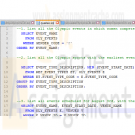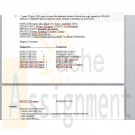Oracle
Need Help in Oracle Assignment?
We can help you if you are having difficulty with your Oracle Assignment. Just email your Oracle Assignment at admin@assignmentcache.com.
We provide help for students all over the world in Oracle Assignment.
-

ITSE 2309 Project Database Programming Oracle Olympics Database
$30.00ITSE 2309 Project Database Programming Oracle Olympics Database
Project Objective: Design and implement a database from requirements and execute queries using SQL.
1. Design a database for tracking Olympic events and results.
2. Write scripts to create the database and populate the tables.
3. Write SQL queries to produce reports.Deliverables
1. Create an ER Diagram for your Olympics database.
2. Write a short design document (1 or 2 pages) describing your choices and reasons for designing your database as you did.
3. Provide scripts to create, populate, and teardown the Olympics database.
A. makeOlympicsDb.sql – Script to create tables, constraints, & any DB objects.
B. populateOlympicsDb.sql – Script to add records to the database tables.
C. dropOlympicsDb.sql – Script to delete all tables and database objects.
4. Provide one or more scripts (with .sql file extension) to execute the queries defined for the project. Each script should include comments with your name and query/question number.Database Requirements
The International Olympic Committee is creating a database for their upcoming summer Olympic games. Each sport has competitions for several different events. The competitions for each sport are assigned to a specific venue. A competitor is an individual athlete representing a particular country. Each event is scheduled for a single day and time, and we save a single result for each athlete competing in the event.
Note: For this project, there are no qualifying rounds.
The goal of the database is to identify when and where competitions occur, the athletes competing in events, and the medalists for each competition. Medals are awarded:
1. Gold for 1st place
2. Silver for 2nd place
3. Bronze for 3rd place
For each competition, results are stored for each athlete. The results are recorded as an elapsed time, a score, or a measurement.Data Population
To test the database, you need to populate with data to demonstrate that the database will meet requirements and produce desired reports. For demonstration purposes, the data should be populated with events and competitors for Gymnastics, Track and Field, and Swimming. Use your own creativity to name athletes and choose countries for the competitions. Provide at least 5 competitors for each event. Some athletes should compete in multiple events and some compete in only a single event.Queries
Learn More
1. List all the Olympic events in which women compete, sorted alphabetically. No duplicates.
2. List all the Olympic sports with the earliest event date/time and latest event date/time for the events contested in the sport. Order results by the name of the sport. Each sport should only be listed once.
3. List all events scheduled for August 3rd, with the time and venue of the event. Sort events by the time, with the earliest event listed first. If more than one event starts at the same time, sort by the name of the event.
4. For Gymnastics, list each event and the names of all the athletes competing in those events. Sort results by the name of the event, and secondarily by the name of each athlete.
5. List all the countries in your database and the number of individual athletes from each country. Sort by country name.
6. List all the names of athletes who compete in more than one event along with the name of his/her event and the competition date/time. Sort results by the athlete’s name.
7. List each sport, the names of each event (including gender), and the number of competitors entered into each event.
8. List results for Track and Field’s 100 Meter race with times for each athlete, with fastest time first. List the athlete’s name, country, and race time.
9. List all medal results for events that have already occurred and been entered into the Olympics database. List the sport, event, athlete’s name, country and medal (Gold/Silver/Bronze). Order results by the sport, event, and place. (Gold Medal = 1st Place, Silver = 2nd Place, Bronze = 3rd Place)
10. List the countries that won the most cumulative medals in descending order, listing the number of gold, silver, and bronze medals, along with the total. Report should be sorted with the most medals listed first in the report down to the country with the fewest medals. If countries have the same number of medals, the most Gold/Silver/Bronze next followed by alphabetic listing by country name. -

MSCD610 Oracle Database Exam Oracle 11g SQL 2nd Casteel
$30.00MSCD610 Oracle Database Exam Oracle 11g SQL 2nd Casteel
True/False (2 points each)
Indicate whether the sentence or statement is true or false.
1. A one-to-many relationship means that an occurrence of a specific entity can only exist once in each table.
2. A table name can consist of numbers, letters, and blank spaces.
3. A constraint can only be created as part of the CREATE TABLE command.
4. The MODIFY clause is used with the ALTER TABLE command to add a PRIMARY KEY constraint to an existing table.
5. If a FOREIGN KEY constraint exists, then a record cannot be deleted from the parent table if that row is referenced by an entry in the child table.
6. By default, the lowest value that can be generated by a sequence is 0.
7. Search conditions for data contained in non-numeric columns must be enclosed in double quotation marks.
8. Data stored in multiple tables can be reconstructed through the use of an ORDER BY clause.
9. Rows can be updated through a simple view as long as the operation does not violate existing constraints and the view was created with the WITH READ ONLY option.
10. By default, the column headings displayed in a report are in upper-case characters.Multiple Choice (3 points each)
Identify the letter of the choice that best completes the statement or answers the question.
11. Suppose that a patient in a hospital can only be assigned to one room. However, the room may be assigned to more than one patient at a time. This is an example of what type of relationship?
a. one-to-many c. one-to-all
b. many-to-many d. one-to-oneContents of the BOOKS table
12. Which of the following will display the new retail price of each book as 20 percent more than it originally cost?
a. SELECT title, cost+.20 "New Retail Price" FROM books;
b. SELECT title, cost*.20 "New Retail Price" FROM books;
c. SELECT title, cost*1.20 "New Retail Price" FROM books;
d. none of the aboveStructure of the CUSTOMERS table
13. Which of the following commands will increase the size of the CITY column in the CUSTOMERS table from 12 to 20 and increase size of the LASTNAME column from 10 to 14?
a. ALTER TABLE customers
MODIFY (city VARCHAR2(+8), lastname VARCHAR2(+4));
b. ALTER TABLE customers
MODIFY (city VARCHAR2(20), lastname VARCHAR2(14));
c. ALTER TABLE customers
MODIFY (city (+8), lastname (+4));
d. ALTER TABLE customers
MODIFY (city (20), lastname (14));14. Which of the following statements about the FOREIGN KEY constraint is incorrect?
a. The constraint exists between two tables, called the parent table and the child table.
b. When the constraint exists, by default a record cannot be deleted from the parent table if matching entries exist in the child table.
c. The constraint can reference any column in another table, even a column that has not been designated as the primary key for the referenced table.
d. When the keywords ON DELETE CASCADE are included in the constraint definition, a corresponding child record will automatically be deleted when the parent record is deleted.15. Which of the following SQL commands will require the user RTHOMAS to change the account password the next time the database is accessed?
a. ALTER USER rthomas PASSWORD EXPIRE ;
b. ALTER USER rthomas CHANGE PASSWORD;
c. ALTER USER rthomas UPDATE PASSWORD;
d. ALTER USER rthomas EXPIRE PASSWORD;16. To instruct Oracle to sort data in ascending order, enter ____ after the column name in the ORDER BY clause.
a. Asc c. ascending
b. A d. either a or c17. Which of the following is an accurate statement?
a. When the LOWER function is used in a SELECT clause, it will automatically store the data in lower-case letters in the database table.
b. When the LOWER function is used in a SELECT clause, the function stays in affect for the remainder of that user's session.
c. When the LOWER function is used in a SELECT clause, the function only stays in affect for the duration of that SQL statement.
d. none of the above18. Which of the following functions allows for different options, depending upon whether a NULL value exists?
a. NVL c. IFNVL
b. IFNL d. NVL2Contents of the ORDERS table
19. Based on the contents of the ORDERS table, which of the following SQL statements will display the number of orders that have not been shipped?
a. SELECT order#, COUNT(shipdate)
FROM orders
WHERE shipdate IS NULL;
b. SELECT order#, COUNT(shipdate)
FROM orders
WHERE shipdate IS NULL
GROUP BY order#;
c. SELECT COUNT(shipdate)
FROM orders
WHERE shipdate IS NULL;
d. SELECT COUNT(*)
FROM orders
WHERE shipdate IS NULL;20. Which of the following is not an example of formatting code available with the FORMAT option of the COLUMN command?
a. Z
b. 9
c. ,
d. .
Completion (4 points each)
Complete each sentence or statement.
21. A(n) ____________________ is a group of interrelated files.
22. In an arithmetic expression, multiplication and ____________________ are always solved first in Oracle.
23. If a constraint applies to more than one column, the constraint must be created at the ______Table______________ level.
24. After a value is generated, it is stored in the ____________________ pseudocolumn so it can be referenced again by a user.
25. The ____________________ function is used to round numeric fields to a stated position.
SQL
26. (5 points) Consider an employee database with relations where the primary keys are underlined defined as:
EMPLOYEE (employee name, street, city)
WORKS (employee name, company_name, salary)
A – Using sql functions as appropriate, write a query to find companies whose employees earn a higher salary, on average, than the average salary at ABC Corporation27. (7 points) Write a SQL script to create this relational schema. Execute the script against the ORACLE database to implement physical database tables. Integrity constraints are listed below.
EMPLOYEE (name, SSN, BDate, Sex, Salary, SuperSSN, DNO)
DEPARTMENT (DName, DNumber, MGRSSN, MGRStartDate)
DEPTLOCATION (DNumber, DLocation)
PROJECT (PName, PNumber, PLocation, DNum)
WORKSON (ESSN, PNO, Hours)
DEPENDENT (ESSN, DEPENDENT_NAME, Sex, BDate, Relationship)Integrity Constraints:
Primary key = Foreign Key
EMPLOYEE.SSN = DEPENDENT.ESSN
EMPLOYEE.SSN = WORKSON.ESSN
EMPLOYEE.SSN = DEPARTMENT.MGRSSN
EMPLOYEE.SSN = EMPLOYEE.SuperSSN
DEPARTMENT.DNumber = EMPLOYEE.DNO
DEPARTMENT.DNumber = DEPTLOCATION.DNumber
DEPARTMENT.DNumber = PROJECT.DNum
PROJECT.PNumber = WORKSON.PNO28. (18 points) Write SQL syntax to resolve the following queries.
Learn More
- Find the names of all employees who are directly supervised by the employee named “John Doe”
- List the name of employees whose salary is greater than the average salary of his or her corresponding department
- For each department, retrieve the department name and the average salary of all employees working in that department. -

MSCD610 Week 7 Course Project Details Hotel Database
$30.00MSCD610 Week 7 Course Project Details Hotel Database
The course project is to develop a Data Model and Database Design for a set of business case requirements. Students should informally review their ER model with the facilitator in week 4 or 5.
This project should follow a top-down database design process and produce the following outputs:
1. A set of business information requirements in the form of a business case abstract.2. A complete ERD that models those requirements.
This model should include the following:
a. A definition of each entity
b. The unique identifier for each entity
c. The attributes associated with each entity
d. The relationships between the entities including their cardinality, optionally, and names3. A physical implementation of a database from the logical design (ERD).
The tables should be normalized to 3NF. For this design include:
a. The name for each table
b. The primary key for the table, and any secondary keys
c. Any foreign keys
d. A data dictionary
e. Any sample data available4. The DDL scripts for implementing the physical database design for this database. Include the referential integrity constraints for these tables. Also include the DDL for any needed indexes and/or views. If necessary, indicate any database tuning which is anticipated on this database.
5. Create the designed Oracle database, and load it with sample data. Then print the definition of the tables, indexes, and any views. Print sample report(s) showing the query definitions in the business requirements have been met.
Learn More




